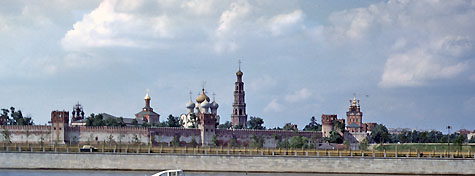Unit 11: Medieval Russia 
Novodevichy Monastery, along the Moscow River outside of Moscow. This medieval Russian monastery was founded by Grand Prince Vasilii III in 1524 to commemorate his capture of Smolensk from the Lithuanians. The convent--the name means "New Young Girls Convent"--is like a miniature Kremlin, especially with its magnificent 5-domed Smolensk Cathedral. The convent has been the focal point of some interesting Russian history. When Peter the Great wanted to rid himself of his older step-sister, he had Sofia confined to this monastery from 1689 until her death in 1704. When Napoleon planned his retreat from Moscow in 1812, he intended to destroy the Convent but legend has it that the nuns discovered the fuses leading to barrels of gunpowder just in time to extinguish them. In 1898, the Convent created the "New Cemetery" beyond the wall for burial of Russia's leading artists. Anton Chekhov was buried there, and then Nikolai Gogol's remains were moved there. Others interred included Vladimir Mayakovskii, Mikhail Bulgakov, Ilia Ehrenburg, Fyodor Chaliapin, Sergei Prokofiev, Valentin Serov, Isaac Levitan, Vladimir Nemirovich-Danchenko, Konstantin Stanislavskii, Dmitrii Shostakovich, Nadezhda Alliluyeva (Stalin's wife), Molotov, Raisa Gorbachev and Nikita Khrushchev. It is truly a list of Russia's creative elite (You'll have to read about them in HIS 242). 
|